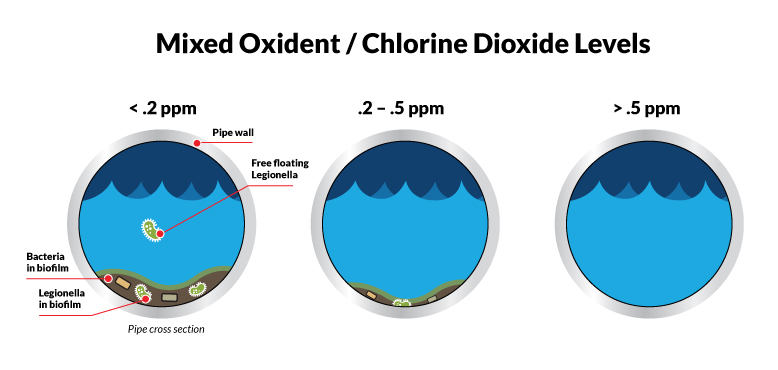Legionella Control Chlorine Dioxide Systems
For support regarding any of our Legionella control water softeners or other pathogen control products and services, please contact our friendly team.
Hours: 24 hours per day, 7 days per week
Tel: 888-416-8626
Email: info@legionellacontrolsystems.com
Contact us for a quote on your chlorine dioxide system:
Tel: +1 888-416-8626
Email: info@legionellacontrolsystems.com
What is a chlorine dioxide system?
Chlorine dioxide (ClO2) is a disinfectant that is commonly used to treat for Legionella in potable water and utility water systems. It is usually generated onsite then injected into hot water lines to destroy bacteria like Legionella as well as other bacteria and viruses.
Chlorine dioxide applications and Legionella control
Chlorine dioxide (ClO2) is commonly used as a powerful disinfectant across the world for Legionella and pathogen control in potable and utility water systems. The Environmental Protection Agency (EPA) recognizes ClO2 as a drinking water disinfectant. They regulate that the maximum concentration allowed in drinking water is 0.8 ppm. ClO2 is commonly used in hospitals, health care facilities and cooling towers as an effective way to eliminate Legionella and bacteria. It is also used in the food and beverage industries for different steps in the processes including cleaning produce such as fruits and vegetables.
How do you size a Legionella control chlorine dioxide system?
Legionella chlorine dioxide systems are sized using daily water use, peak water use, water quality and desired residual. Use our sizing calculator today.
How does chlorine dioxide work to control Legionella:
Chlorine dioxide works directly on the cells’ oxidizable material causing the cell metabolism to be disrupted. Chlorine dioxide is an good disinfectant for legionella due to its ability to efficiently remove biofilm from piping. Biofilm in water piping protects legionella from most disinfectants but ClO2 breaks up biofilm releasing the bacteria into the water where it is easily killed. This biofilm is made up of polysaccharides, which cause most disinfectants to be used up trying to penetrate it. ClO2 penetrates this layer and works directly on the bacteria making up the biofilm.
Though chlorine is in the name there are major differences between Chlorine (Cl2) and chlorine dioxide (ClO2). Both are strong oxidizers but what makes ClO2 more efficient is its ability to take on three more electrons than that of chorine. CL2 can take on two electrons while ClO2 can take on five electrons. It also uses the killing process radical electrophilic abstraction. Meaning it attracts electrons. Cl2 uses oxidative subtraction or addition. Meaning ClO2 also does not create the chlorinated organic compounds such as THMs (trihalomethanes) and HAAs (halogenic acetic acids). Since the CLO2 does not have nearly the interaction with organic compounds that Cl2 does it allows for much more of the chemical to be used for disinfectant. This means that ClO2 is around 2.6 times more efficient per ppm than standard Cl2. Chlorine Dioxide produces chlorites in the water, which need to be monitored on a daily basis for water safety.
Legionella control chlorine dioxide systems and service
Need more information on Legionella control systems? Contact Legionella Control Systems at info@legionellacontrolsystems.com or 888-416-8626 for design, service and sales of Legionella control chlorine dioxide systems in Indiana, the Midwest and throughout the U.S. Our experienced engineers are ready to help.
Contact Legionella Control Systems for CDC Legionella risk assessment and Legionella testing.








